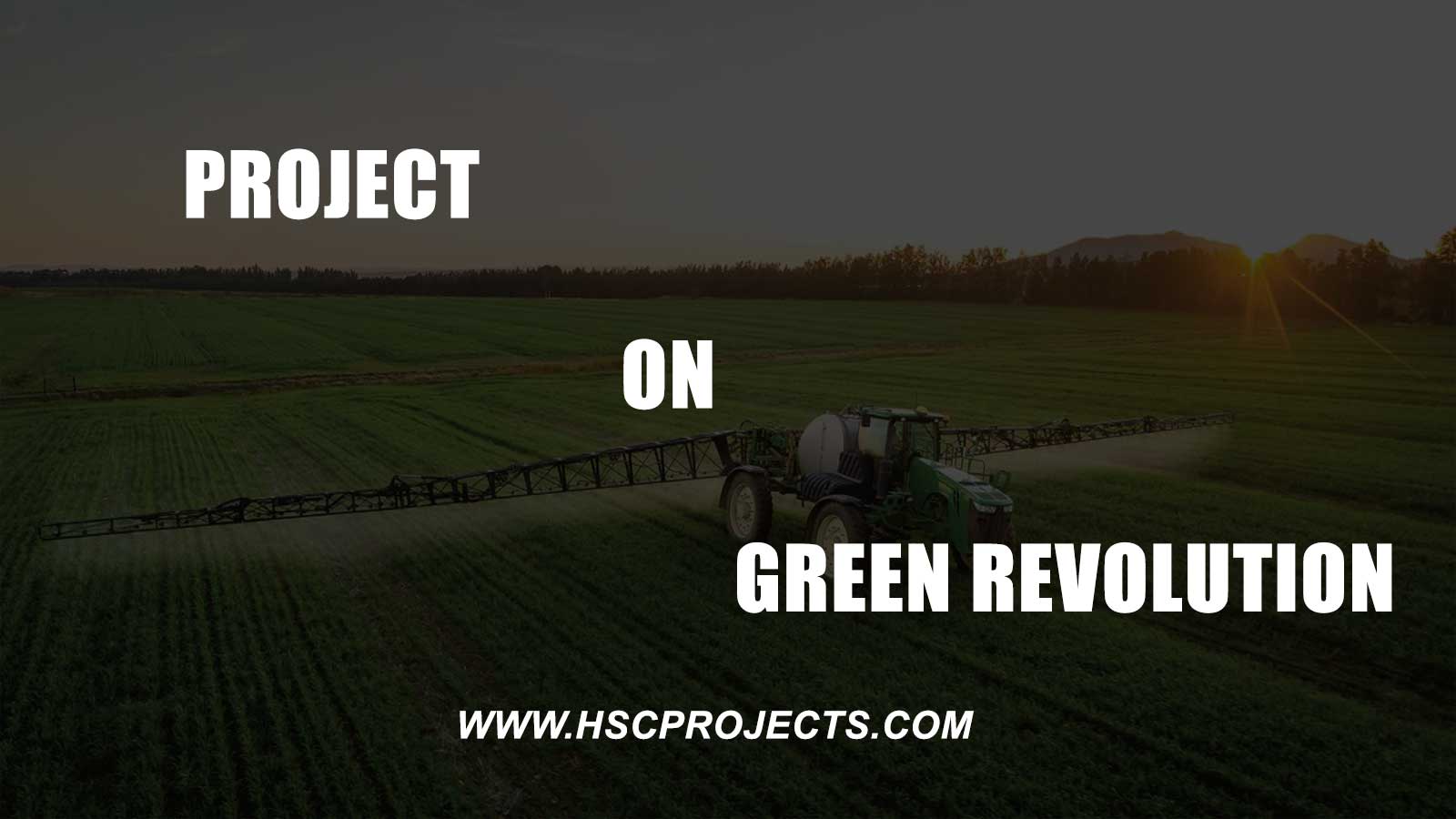
EVS Project On Green Revolution For Class 11th & 12th CBSE
INTRODUCTION OF THE GREEN REVOLUTION
The green revolution was a period when the productivity of global agriculture increased drastically as a result of new advances. During this period, new chemical fertilizers and pesticides were created. The chemical fertilizer made it possible to supply crops with extra nutrients and therefore, increase yield. The newly developed pesticides controlled weeds, deterred or kill insects, and prevented disease which also resulted in higher productivity. It is an important part of EVS subject to have a project on green revolution with a project report on green revolution for class 11 and 12.
HISTORY AND DEVELOPMENT OF THE GREEN REVOLUTION
The beginnings of the Green Revolution are often attributed to Norman Borlaug American scientist interested in agriculture. Dr. Norman E. Borlaug receives the congressional Gold Medal in 2007 Borlaug a 1970 Nobel laureate was honored for his work in the Green Revolution saving millions of lives from famine in India Mexico and the Middle East.
GREEN REVOLUTION IN INDIA
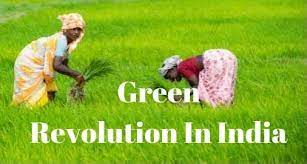
- In 1965 the government of Mrs. Indira Gandhi decided to major steps on agriculture conditions.
- Thus Green Revolution was applied to the period from 1967 to 1978 basically in the parts of Haryana and Punjab.
- At this stage, concern was on Wheat and Rice.
- Dr. MS Swaminathan from India led Green Revolution as a project.
METHODS USED IN THE GREEN REVOLUTION
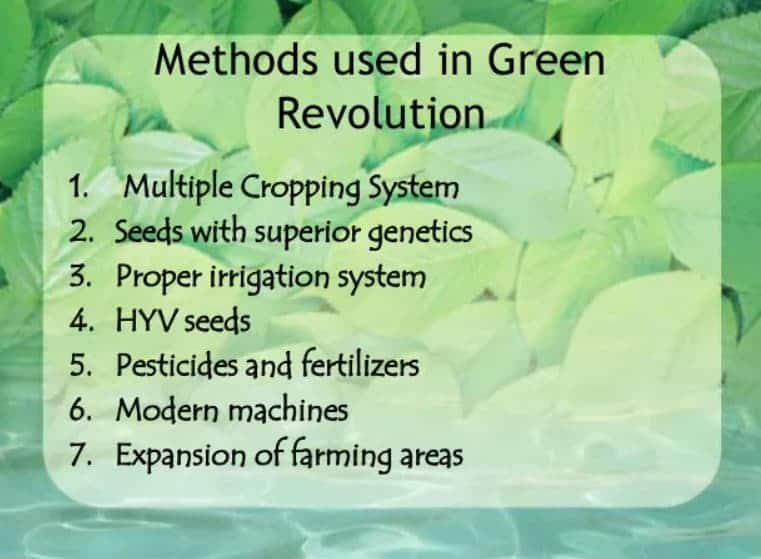
- Multiple cropping systems: since India had only one rainy season every year farmers in the country practice one crop season per year. However, the Green Revolution introduced huger irrigation projects to make water available for other crops. Hence farmlands now had two crop seasons per year.
- Seeds with superior genetics: the Indian Council for Agricultural Research, which the British had established in 1929, was recognized in 1963 and 1975. The council developed new strains of high-yield variety seeds mainly wheat and rice and also millet and corn.
- Proper Irrigation system: the artificial monsoon came in the form of huge irrigation facilities dams were built to arrest large volumes of natural monsoon water which were earlier being wasted.
- HYV seeds: the council developed new strains of high yield variety seeds many wheat and rice but also millet and corn were developed.
- Pesticides and fertilizers: use of pesticides and weedicides to reduce any loss or damage to the crops. Increased availability and use of fertilizers to enhance the productivity of the farms.
- Modern Machines: Finally the introduction of technology and machinery like tractors harvesters, drills, etc. helped immensely to promote commercial farming in the country.
- Expansion of farming areas: In past independence, India needed to expand its cultivable land to meet the rising demand.
GENERAL REVOLUTION
A large increase in food production in developed and developing countries was achieved by using modern agricultural techniques.
CAUSES OF THE GREEN REVOLUTION
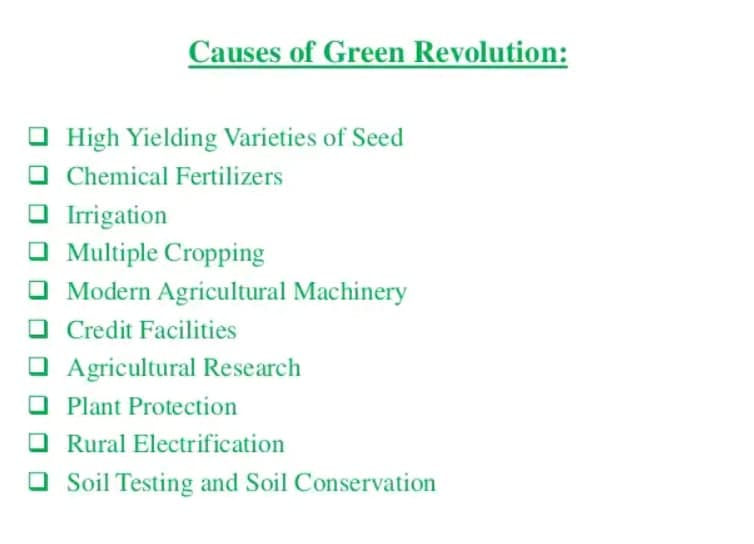
- Irrigation
Better irrigation facilities are responsible for the green revolution. In 1965-66, 22 lakh hectares area had irrigation facility while 76 lakh hectares area got this facility in the year 2002-03 tube well irrigation has rapidly increased. - Agricultural Machinery
In Punjab agriculture is mechanized. Tractors, harvesting combines tube wells and pumping sets and threshers, etc. are intensively used in Punjab. Punjab has the largest number of tractors In 1966 there were 10 thousand tractors, while in 2002-03, it increased to 3.54 lakhs. - Fertilizers
The use of chemical fertilizers has increased the production of food grains to large extent. In 1965-66 chemical fertilizers were used 97 thousand tonnes. In 2002-03 their use increased to 1441 thousand tonnes. - High yielding variety of seeds (HYV)
The use of HYV seeds has played a major role in increasing agricultural production. For example, the per hectare yield of wheat has increased from 1200 Kgs to 4500 Kgm. In the case of rice, the yield increased from 1000 Kgs to 3500 Kgs. So HYV seeds have increased production tremendously. - Plant protection
There was no arrangement to protect the plants against disease in previous times. So crops were damaged on large scale. Now there are proper arrangements to protect the plants against diseases and pests. Pesticides are sprayed to protect the plants. Plant clinics are opened to provide expert advice to farms against diseases. - Research
Punjab Agricultural University (PAU) Ludhiana has done a lot of research on agricultural problems. The university provided better quality seeds for wheat rice cotton gram, maize, sugarcane, and oilseeds. The university organizes Kisan meals twice a year to provide knowledge of new agricultural techniques to farmers. - New techniques
Punjab Agricultural University Ludhiana has been imparting training to farmers under the Intensive Agriculture district program (IADP). Under this program, much attention is paid to crop rotation, chemical fertilizers use of HYV seeds and water, etc. - Multiple cropping
Proper arrangement of irrigation and use of HYV seeds, enabled the farmers to grow more than one crop in a year. - Price Incentive
Rich harvest can bring down the price to avoid this prices of various agricultural produces are fixed by agriculture cost and price commission Govt buys agriculture to produce a minimum price fixed by the commission through agencies like food corporation of India, Mark fed and puns up, etc.
RESULT/EVALUATION OF GREEN REVOLUTION
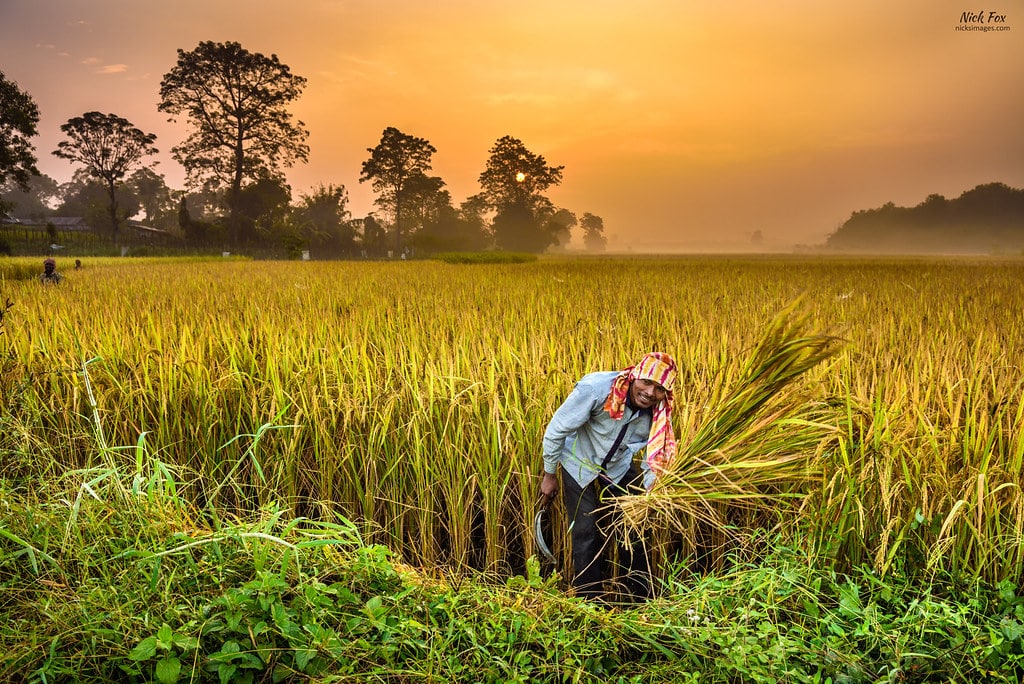
- Statistical Result
The green revolution resulted in a received grain output of 131 million tons in 1978-79.
This established India as one of the world’s biggest agricultural producers.
No other country in the world which attempted the green Revolution recorded such a level of success. - Economical Result
The increase in irrigation created the need for new dams to harness monsoon water.
This in turn boosted industrial growth, created jobs, and improved the quality of life of the people.
India paid back all loans taken from the world bank for the green revolution. - Sociological result
The Green Revolution created plenty of jobs not only for agricultural workers but also for industrial workers.
The creation of lateral facilities such as factories and hydroelectric power stations helps to uplift the social as well as the economic condition. - Political Result
India transformed itself from a starving nation to an exporter of food.
The green revolution was one factor that made Mrs. Indira Gandhi (1917-84) and her party, a very powerful political force in India. - Other Result
Poorer farmers cannot achieve yields as high as those with better access to water, fertilizer, and land.
More people own land but it is being divided into smaller and smaller plots
This is because of population growth and land redistribution schemes.
EFFECTS OF THE GREEN REVOLUTION
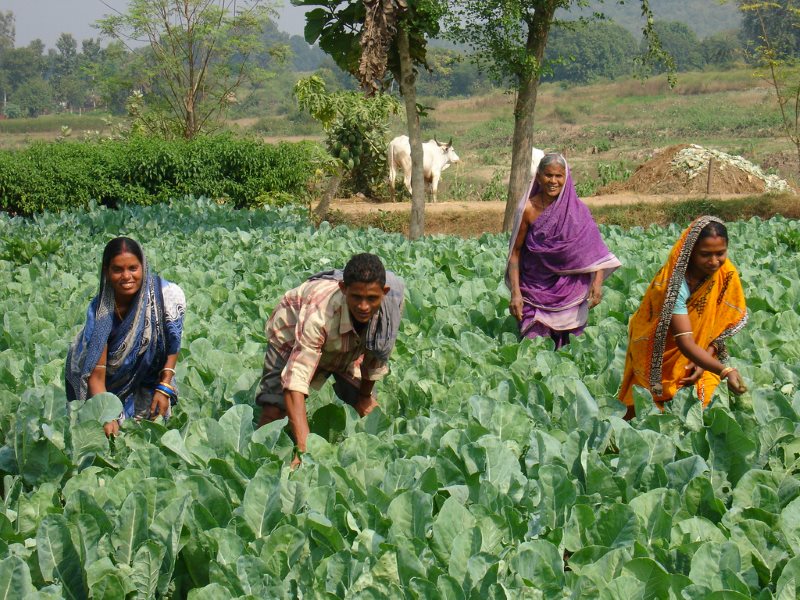
- Increase in production
The first major direct effect of the green revolution has been the sharp increase in agricultural production. As a result of the new agricultural strategy, food grains output increased substantially. So far as food grains are concerned, wheat seems to have made rapid strides with its production increasing from 11.1 million tons in the third plan (annual average ) to 63 million tons in 1995-96 - Increase in per Acre yield
Not only did the Green Revolution increase the total agricultural output, but it also increased the per hectare yield. In the case of wheat, the per hectare yield increased from 850 kg/hectare to an incredible 2281 kg/hectare by 1990. - Rural Employment
Capital-intensive techniques of the new agricultural strategy are supposed to be also at the same time labor-intensive. This new technology is characterized by frequent application of water fertilizers, insecticides, double cropping larger volumes of transportation, marketing, and food processing. This will lead to increased income among agricultural laborers and small farmers. - Less dependence on Imports
After the green revolution, India was finally on its way to self-sufficiency, there was now enough production for the population and to build stock in case of emergency we did not need to import grains or depend on other countries for our food supply. India was able to start exporting its agricultural produce. - Development of industries
An important aspect of the new agricultural strategy is the stress it lays, on making agriculture dependent on industries for its inputs. Traditional Indian agriculture was self-sufficient in the matter of its input requirements. But the new strategy attaches great importance to industrial products as agricultural inputs. - A benefit to the farmers
The Green Revolution majorly benefited the farmers. Their income saw a significant raise. Not only were they surviving, but they were also prospering which enabled them to shift to commercial farming from only sustenance farming.
IMPORTANT ASPECTS OF GREEN REVOLUTION
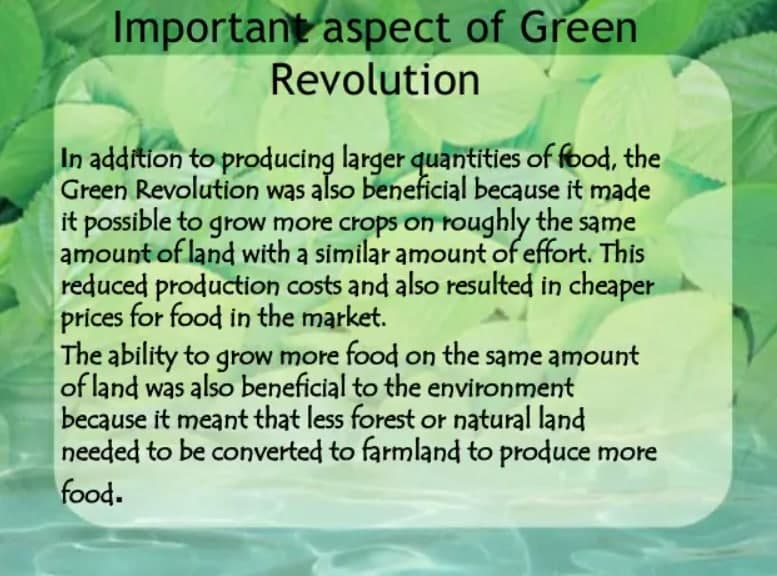
In addition to producing larger quantities of food, the Green Revolution was also beneficial because it made it possible to grow more crops on roughly the same amount of land with a similar amount of effort. This reduced production costs and also resulted in cheaper prices for food in the market. The ability to grow more food on the same amount of land was also beneficial to the environment because it meant that less forest or natural land needed to be converted to farmland to produce more food.
ISSUES REGARDING GREEN REVOLUTION
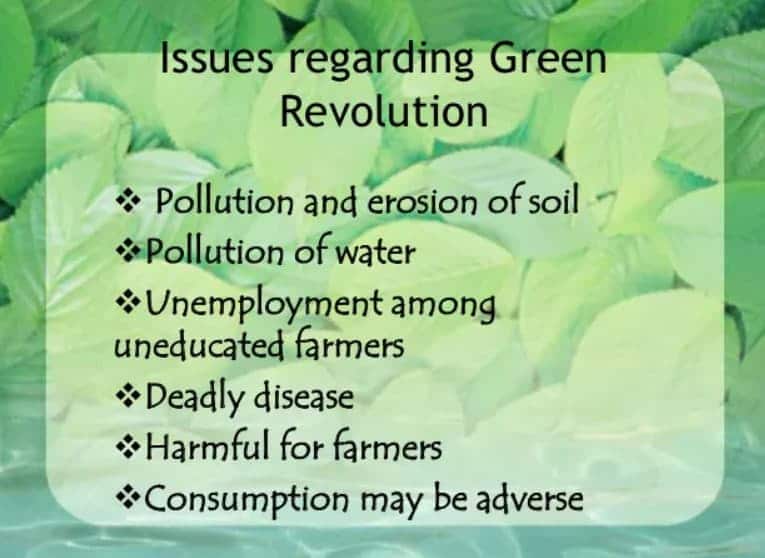
- Pollution and erosion of soil
The fertility of the soil has become poor due to the implementation of modern techniques. Chemical herbicides contribute to air water and soil pollution not only do they pollute the soil where they have been applied but rainwater can carry these chemicals to other areas. - Pollution of water
Some chemical herbicides end up in waterways where they kill fish and other aquatic life, according to a study published in the Japanese Journal of Veterinary Research. It can also evaporate into the air resulting in air pollution and reduced air quality. - Unemployment among uneducated farmers
The farmers are largely dependent on the market for the supply of inputs and the demand for their products. There has been displacement of agricultural labor by extensive use of agricultural machinery and leaving them unemployed. - Harmful for farmers
At the same time, the demand for agricultural credit has also increased as the new technology has increased the cash requirements of the farmers. Poor farmers were not able to get loans easily. - Weeds have increased
Due to the heavy crop rotation pattern, we do not give rest to land nor do we have time to employ a proper weed removal system that has increased weeds. - Loss of biodiversity
Due to the heavy use of chemical pesticides, insecticides and fertilizers we have lost many birds and friendly insects and this is a big loss in long term. - Excessive use of pesticides
During the green revolution, farmers used excessive pesticides these pesticides mixed with groundwater and thus spoiled the health of the people of the areas of the green revolution. - Deadly disease
The new farming techniques have given birth to the serious pollution of drinking water causing cancer and another disease.
PRECAUTIONS
- Proper planning and implementation of the agricultural plan.
- Avoiding access to the use of chemical fertilizers and pesticides.
- Proper irrigation system to that water wastage can be controlled.
- Frequent pollution control checks of the soil should be done.
CONCLUSION
Green Revolution has done a lot of positive things saving the lives of millions of people and exponentially increasing the yield of food crops. But environmental degradation makes the Green Revolution an overall inefficient short-term solution to the problem of food insecurity. So a more sustainable and environmentally-friendly system of cultivation needs to be practiced. The world needs green revolution 2, which promises to feed a growing world population sustainably without compromising the needs of future generations.
You can use this project to write note on green revolution for class 11 and 12.
NEED FOR SECOND GREEN REVOLUTION
India has tremendous export potential in agriculture in the present era of globalization. In the second Green Revolution emphasis should be laid on
- Non-food grains
- Improving global market opportunities.
- Improving rural infrastructure
- Improving rural roads and electrification
ACKNOWLEDGEMENT
I would like to express my special thanks of gratitude to my teacher Daizy Gupta as well as our principal Nelinder Jeet Sandhu who gave me the golden opportunity to do this wonderful project on Green Revolution which also helped me in doing a lot of research and learning new things. I am thankful to them. Secondly, I would also like to thank my parents and friends who helped me a lot in finalizing the project within the limited time frame. It is important for students to learn about green revolution and the best way to learn is a project on green revolution for evs class 11 and class 12.
BIBLIOGRAPHY
I would like to mention some sources which proved to help make this project some of them are as follows
- www.google.com
- www.wikipedia.com
- Google images
- www.economicsdiscusssion.net
- https://www.slidshare.net
DOWNLOAD PDF OF THE PROJECT
12th hsc evs project pdf

Password: hscprojects.com
In order to download the PDF, You must follow on Youtube. Once done, Click on Submit
Follow On YoutubeSubscribed? Click on Confirm
Download EVS Project On Green Revolution For Class 11th & 12th CBSE PDF






